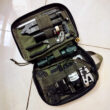We’ve all been there. Trying to get as much use out of your phone only for it to inevitably die leaves you feeling as powerless as your battery. Although the technology in our gadgets is continuously improving, the batteries in them aren’t. Chances are, you’re carrying at least one item powered by a rechargeable battery. If you find yourself looking for a power source more often than you’d like, then an external battery is something to consider adding to your EDC. With so many different options to choose from, we’ll show you what to look for and recommend some of the best portable battery packs to get you started.
How to Pick a Battery Pack for Everyday Carry
Power banks come in all shapes and sizes. The key is to pick one that will give you the extra power you need without it taking up too much space. You won’t need to ask people to borrow a charger, and you can use your devices a little more freely knowing that you can charge up whenever you want. Keep these key aspects in mind when picking a portable external battery:
1. Know these basic terms to be able to compare battery packs.
You’ll have a much easier time comparing different battery packs if you understand the terms, numbers, and units commonly listed on spec sheets. Some basic knowledge should be enough to get you started, so we won’t delve too deeply into physics and technical jargon for this guide.
Battery packs typically refer to their capacity in mAh, or milliampere-hour. The portable battery you choose should have around the same capacity in mAh as the battery of the device you intend to charge to be able to get a full recharge. For example, if you have a 2000mAh battery pack, it can recharge a 1715mAh iPhone 6s to 100% and still have some juice left over. It wouldn’t be able to fully charge the Nexus 6P, which has a much larger battery at 3450mAh. The ability to charge at least 50% of your device’s capacity is a good rule to follow, as that should be enough to last you until you’re able to plug into an outlet.
The other spec to keep in mind is the output, measured in amperes (amps or A). This refers to how quickly the battery can recharge your device. If charging speed is important to you, it’s worth getting a battery with a higher output. For phones and smaller devices, a 1 amp output is common. Look for a higher output of 2 amps for full-speed charging and use with tablets or larger devices that require more power. Since they have bigger batteries, the power bank will deplete quicker as it needs to provide power at a higher rate.
2. Make sure the battery is durable enough to last.
You don’t want a battery pack to break on you when you most need it. Make sure it uses materials that can withstand what you plan on putting it through. If you’re going to keep it somewhere safe like on your desk at work, plastic might be enough. But if you’re going to be carrying it around every day or taking it on some off-road adventure, more durable materials (like aluminum) would serve you better.

3. Choose a form factor based on how you plan to carry the battery pack.
Since you’re already thinking about where you’ll be taking it, the next step is to think about how you’ll be carrying it. If you intend to put the external battery in your pocket, the slimmer the better. But if you have a briefcase or backpack that you never leave home without, then you can sacrifice thinness for a larger sized battery to enjoy more capacity or extra features. It’s all about getting the perfect balance between the functionality and the design. Just because you find a battery with a seemingly endless supply of power, doesn’t necessarily mean that it’s the right one for you.
4. Make sure the connections match your device.
Double check that the battery pack you’re getting is actually compatible with your device. It might seem trivial, but don’t let this small mistake ruin your chances of using the power bank you just spent money on. Most external batteries come with a standard USB output where you provide your own charging cable, but others come with cables built-in. The two most common types you’ll come across will have either a Lightning connector for iOS devices or a micro USB connector.
5. Keep an eye out for bonus features.
A battery pack’s most important job is to charge your device. As a result, most portable chargers are pretty bare-bones in terms of functionality. But others have a bit more to offer, whether they’re features for charging, or different functions entirely. For example, higher end battery packs might have multiple output ports with different currents, battery level indicators, and advanced circuitry. Others combine charging with tools you might want to carry anyway, like a flashlight, charging cable, hand warmer, and so on.
As you can see, a lot of what goes into picking the right battery pack for you is no different from picking any other tool in your EDC. It’s all about finding what works for you. Hopefully you’ll find one that’s the perfect fit for you in our recommendations:
The Best External Batteries and Power Banks
For all-around EDC use:
Anker Astro 2nd Gen
Anker has earned a reputation for making some of the best charging accessories you can get. If you’re looking to add a battery pack to your EDC for general use, chances are that the 2nd gen Anker Astro external battery can get the job done. It’s small, minimal, and packs a 6700mAh battery. That’s enough capacity to charge the average phone two times to three times over. There’s also a small LED circle that lights up to display how much power remains in the battery when you shake it. The single USB output also comes equipped with PowerIQ technology, which identifies the device you plug in and charges it appropriately.
For charging multiple devices:
Limefuel Blast L150X Pro
If you tend to carry a few different electronics, then you’re better off getting something with enough ports and capacity to charge them all. For that, the Limefuel Blast L150X Pro lets you simultaneously charge up to four devices using its 15,000mAh battery. You can even let a friend or two charge their devices without having to unplug your own. But if you do, it won’t be for long, as the power bank features full-speed, 2.1A max output ports for quick recharging. The L150X Pro comes in a sleek and durable aluminum housing that won’t look out of place whether it’s in a briefcase or a backpack.
For the travelers and jet-setters:
Vinsic Power Bank
Many airports now have charging stations to refuel your devices between flights. But why bother with fighting the crowds for a charger when you can just bring your own? The Vinsic Power Bank features a 20,000mAh battery, which is enough power to fully charge an iPhone 6 almost eight times. With that much capacity, this power bank isn’t exactly small and light. But it is slim, letting you easily slide it into your carry-on without sacrificing too much space. There’s also an indicator light on the side that displays in percentages how much power remains. This takes the guesswork out of knowing how many charges you have left, which is especially useful on a battery of this size. The solid plastic and aluminum build makes it durable enough to withstand travel with ease.
For ultra-slim pocket carry:
mophie Powerstation 2X
As the originators of the first iPhone battery case, Mophie has become one of the most recognizable brands in charging solutions. Their new Powerstation 2X external battery is one of their thinnest yet. If you’re not looking to give up too much pocket space, this ultra-slim card form factor is the way to go. At 7.7 mm thin, it’s just slightly thicker than the iPhone 6s, but has a larger 4,000mAh battery and an integrated LED battery level indicator. Its sleek aluminum housing not only looks good, but helps withstand the wear and tear that comes with being carried around in a pocket with other tools. Mophie offers other models in the Powerstation line with bigger capacities as well. So if you like the thin form factor but need a little power, you can find a Powerstation that’ll fit your charging needs (and your pocket).
For the rugged outdoors:
Outdoor Tech OT1600 Kodiak
Outdoor Tech’s products are designed to help you “stay connected but not tethered.” You’ll be hard pressed to find a power outlet outdoors, so whatever battery pack you bring with you on adventures needs to have a decent capacity, durable construction, and portable design. The ruggedized 6000mAh Kodiak OT1600 battery checks all those boxes. Its single USB output can switch between 1A and 2.1A to charge any kind of device in a hurry. The Kodiak 6000 also boasts certified IP67 shock- and waterproofness, making it an ideal charger for your outdoor excursions.
For those on the fence about carrying a power bank:
Aukey mini
Just like with your first pocket knife, one of the best ways to discover how useful a battery pack can be for you is to simply carry one. If you’re not sure how essential a battery pack could be to your EDC, a good one to start with is the Aukey mini. It’s inexpensive, decently portable, and packs enough juice for most people. Inside its drop-tested aluminum barrel casing is a shockproof inductor and capable 5000mAh battery. If you want to experiment with a battery pack in your carry (or if you’re on a tighter budget) the Aukey mini can fit the bill.
For your keychain:
Megalo Mini
Maybe you don’t necessarily need a full recharge on you, but could use a small boost of power to get you through the day. The Megalo mini is an ultra-portable battery that fits on your keychain. It has a 1400mAh battery and even a built-in charging cable for convenience. One thing to keep in mind if you’re thinking about the Megalo is whether your device uses a Lightning connector or micro USB, because you’ll need to purchase the appropriate model. If you’d rather not carry it with your keys, it’s small enough that it can also easily be stored in your coin pocket.
Did you find this guide helpful? If so, please share the article with your friends and followers. What’s your go-to for charging on the go? Tell us your favorite external battery in the comments section below.
Photos by Bernard Capulong
















